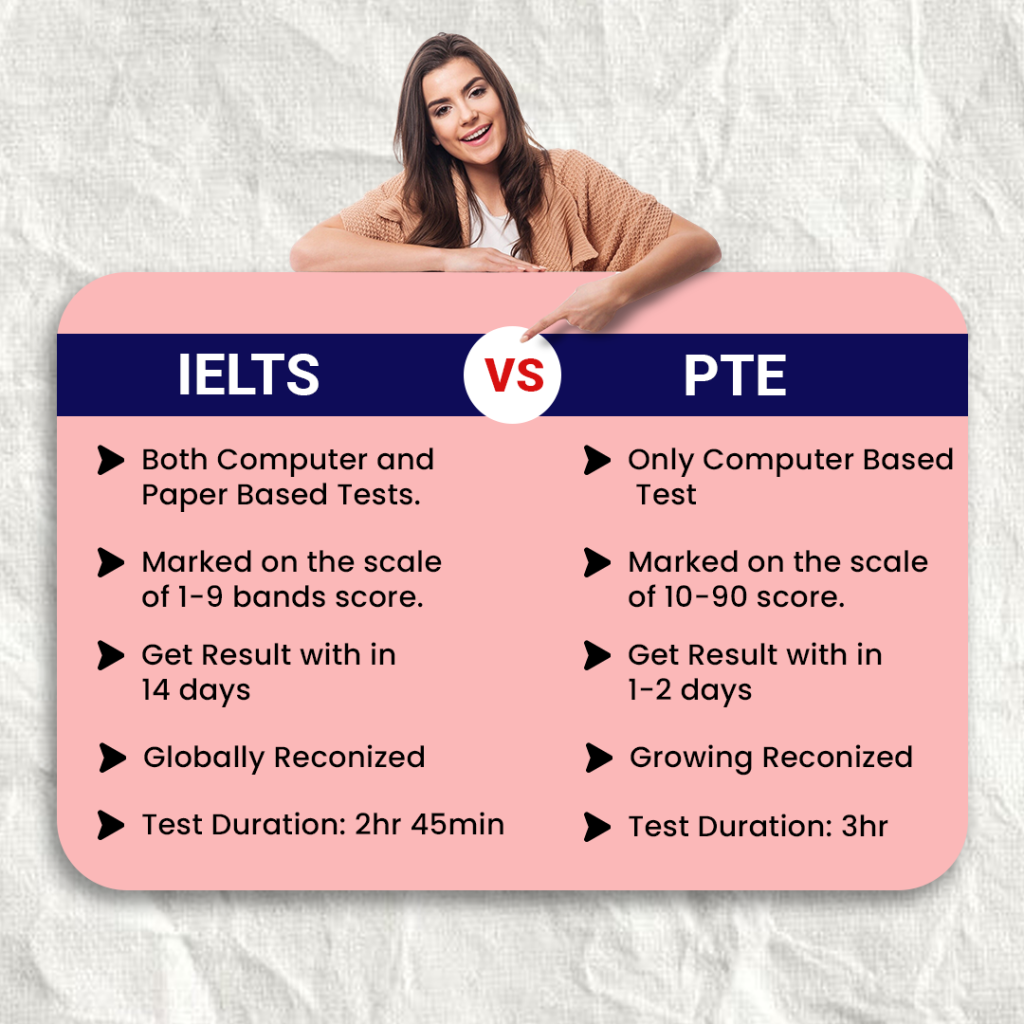If you’re preparing to study or work abroad, the decision to choose between IELTS vs PTE is an important one. Both tests are widely accepted for proving English proficiency, but each has unique features that can impact your test experience and results. Understanding the differences between IELTS and PTE will help you choose between IELTS and PTE based on your strengths, preferences, and specific requirements.
In this guide, we’ll break down everything you need to know to choose between IELTS vs PTE—from test formats and scoring systems to preparation tips and practical advice. Making the right choice between these two tests is essential to maximize your score and feel confident on test day. Let’s explore the details to ensure you choose between IELTS and PTE with all the information you need for a successful international journey.
What is IELTS?
IELTS, or the International English Language Testing System, is one of the most widely recognized English language proficiency tests in the world. It is designed to assess your ability to understand and use English in academic, social, and professional settings. The test is accepted by over 10,000 institutions across the globe, including universities, employers, and immigration authorities.
The test evaluates four key areas of language proficiency:
- Listening – You will listen to a series of recordings and answer questions based on what you hear.
- Reading – This section includes texts based on academic or everyday contexts, depending on the test type.
- Writing – You’ll be required to write essays or reports based on prompts.
- Speaking – In a face-to-face interview, you will answer questions, discuss topics, and give opinions.
IELTS is traditionally a paper-based test, though computer-based options are also available in some locations. The total test duration is about 2 hours 45 minutes, and it’s known for its reliability and thorough assessment of English language skills. This makes it a top choice for students who want to study in English-speaking countries such as the UK, Australia, Canada, and New Zealand.
What is PTE?
PTE, or Pearson Test of English, is another popular English language proficiency test, widely accepted by universities, colleges, and governments around the world. PTE is known for its computer-based format, which aims to provide a more modern and flexible testing experience. It evaluates your English skills in real-life contexts, such as academic settings, work environments, and everyday situations.
The PTE test evaluates your abilities in three main areas:
- Speaking & Writing – You will respond to prompts by speaking and writing, including describing images, summarizing spoken text, and writing essays.
- Reading – This section includes multiple-choice questions, re-ordering sentences, and filling in missing words based on academic texts.
- Listening – You will listen to recordings and answer questions related to the audio, including summarizing and identifying key information.
Unlike IELTS, PTE is entirely computer-based, and all responses are recorded and scored using advanced artificial intelligence technology. The test lasts approximately 3 hours, and you’ll receive your results within 5 business days, making it a fast and efficient option for students who need quick feedback.
PTE is recognized by universities in countries like the UK, Australia, the USA, and Canada, as well as for visa purposes in some countries, making it a solid choice for students and professionals alike.
Key Differences Between IELTS vs PTE
Choosing between IELTS and PTE often depends on understanding the main differences in format, scoring, test duration, and availability. Here’s a breakdown of these differences to help you decide which test might be the better fit for you.
1. Test Format and Question Types
- IELTS offers both paper-based and computer-based options, depending on your preference and location. The test includes tasks such as multiple-choice questions, essays, and face-to-face speaking interviews.
- PTE is entirely computer-based, and all responses, including speaking, are recorded using a microphone and assessed by an AI system. The PTE exam features unique question types like image descriptions and summaries, making it a good option for those comfortable with digital testing.
2. Scoring System
- IELTS uses a band score system ranging from 1 to 9 for each section (Listening, Reading, Writing, and Speaking). Your overall score is an average of the four section scores, with 9 being the highest level of proficiency.
- PTE uses a scaled score system from 10 to 90, with each skill (Speaking & Writing, Reading, and Listening) scored individually and combined for an overall score. The AI scoring system ensures quick and objective results, which can be an advantage for some test-takers.
3. Duration of the Test
- IELTS takes approximately 2 hours and 45 minutes. The Speaking test may be held on a different day from the other sections, depending on the test center.
- PTE takes about 3 hours in one sitting, with all sections completed back-to-back. This format may suit those who prefer to complete the test in a single session.
4. Test Availability and Locations
- IELTS is available in both computer-based and paper-based formats at numerous test centers worldwide. It is widely accepted by institutions globally, making it a reliable choice for students applying to different countries.
- PTE is also available in many locations, but it’s important to confirm if your desired institution or country accepts it. The test’s fully computer-based nature makes it more flexible in terms of scheduling, and results are generally available within 5 business days.
These differences highlight unique advantages for each test. IELTS may be ideal if you prefer a face-to-face speaking test or need more format options, while PTE could be the better choice if you value quick results, a fully digital experience, and AI-driven scoring. Understanding these key aspects can help you make an informed decision that aligns with your goals and testing preferences.

Which Test Should You Take?
Choosing between IELTS and PTE can be challenging, but considering a few key factors can help you determine which test is best suited for your needs. Here are some aspects to consider when making your decision:
1. Choosing Based on Test Format
If you prefer a traditional test experience, IELTS offers both paper-based and computer-based options, as well as a face-to-face speaking interview. For those comfortable with digital technology and looking for a fully computer-based test, PTE may be the better choice, as it uses AI to assess all responses, including speaking.
2. Choosing Based on Recognition and Requirements
Different countries, universities, and institutions have unique requirements for language proficiency tests. IELTS is widely accepted globally, making it a safe option for students applying to various destinations. PTE is also accepted in many English-speaking countries like Australia, the UK, and the USA, but it’s essential to check that it’s recognized by your target institution or immigration program before choosing it.
3. Choosing Based on Your Strengths
Your individual skills can also play a role in choosing the right test. IELTS may suit you better if you feel confident in a structured, conversational speaking format, as its speaking section is conducted face-to-face. PTE, on the other hand, uses a computer-based speaking assessment, which can be a more comfortable option for those who prefer not to speak with an examiner. Additionally, if you’re strong in handling diverse tasks quickly and enjoy a fast-paced test, the AI-scored, technology-focused PTE might align well with your abilities.
Selecting the right test involves understanding both your goals and your strengths. Carefully consider the format, recognition, and specific test sections to choose the option that sets you up for success.
Tips for Preparing for IELTS and PTE
Preparing effectively for IELTS or PTE is key to achieving your target score and feeling confident on test day. Here are some practical tips to help you succeed:
1. Use Official Preparation Materials
Both IELTS and PTE offer official study materials, practice tests, and sample questions. Start with these resources to familiarize yourself with the format and types of questions you’ll encounter. This will give you a solid foundation and help you understand the specific skills each test evaluates.
2. Take Practice Tests Regularly
Practice tests are essential for building your test-taking stamina and assessing your progress. Try to simulate test conditions by setting a timer and working through each section in a single sitting. This will help you manage your time effectively and identify any areas that need improvement.
3. Focus on Time Management
Time is a crucial factor in both IELTS and PTE. Each section has a strict time limit, so practice completing tasks within these constraints. For instance, practice quick reading strategies for the reading sections and concise yet structured responses for writing tasks. The better you manage your time, the more confident you’ll feel during the actual test.
4. Improve Your English Skills Daily
Incorporate English into your daily routine by reading, listening to podcasts, speaking with others, or writing short essays. This ongoing practice can strengthen your language skills, making you more comfortable with the language and better prepared for either test.
5. Review Test-Taking Strategies
Each test has unique question types, such as summarizing spoken text in PTE or describing images, which may differ from tasks in IELTS. Research strategies specific to each test, such as paraphrasing skills for IELTS essays or sentence reordering techniques for PTE reading. Being familiar with these strategies will help you tackle different question types confidently.
6. Work with a Tutor or Take a Prep Course
Consider working with a tutor or enrolling in a prep course, especially if you have specific areas of concern. Expert guidance can provide personalized feedback, test-taking tips, and structure to your study plan, which can be especially helpful in building confidence and readiness.
Choosing between IELTS and PTE is an important decision that can impact your journey toward studying or working abroad. Both tests are widely recognized and assess your English proficiency across essential skills, but each has its own format, scoring system, and unique features. By understanding these differences, considering your goals, and assessing your personal strengths, you can select the test that best suits your needs.
Ready to start your journey toward studying or working abroad? Whether you choose IELTS or PTE, preparation is the key to success. Contact us today to learn about our test preparation courses, expert guidance, and personalized study plans designed to help you achieve your target score. Let’s work together to make your international dreams a reality! Reach out now to schedule your first consultation.







